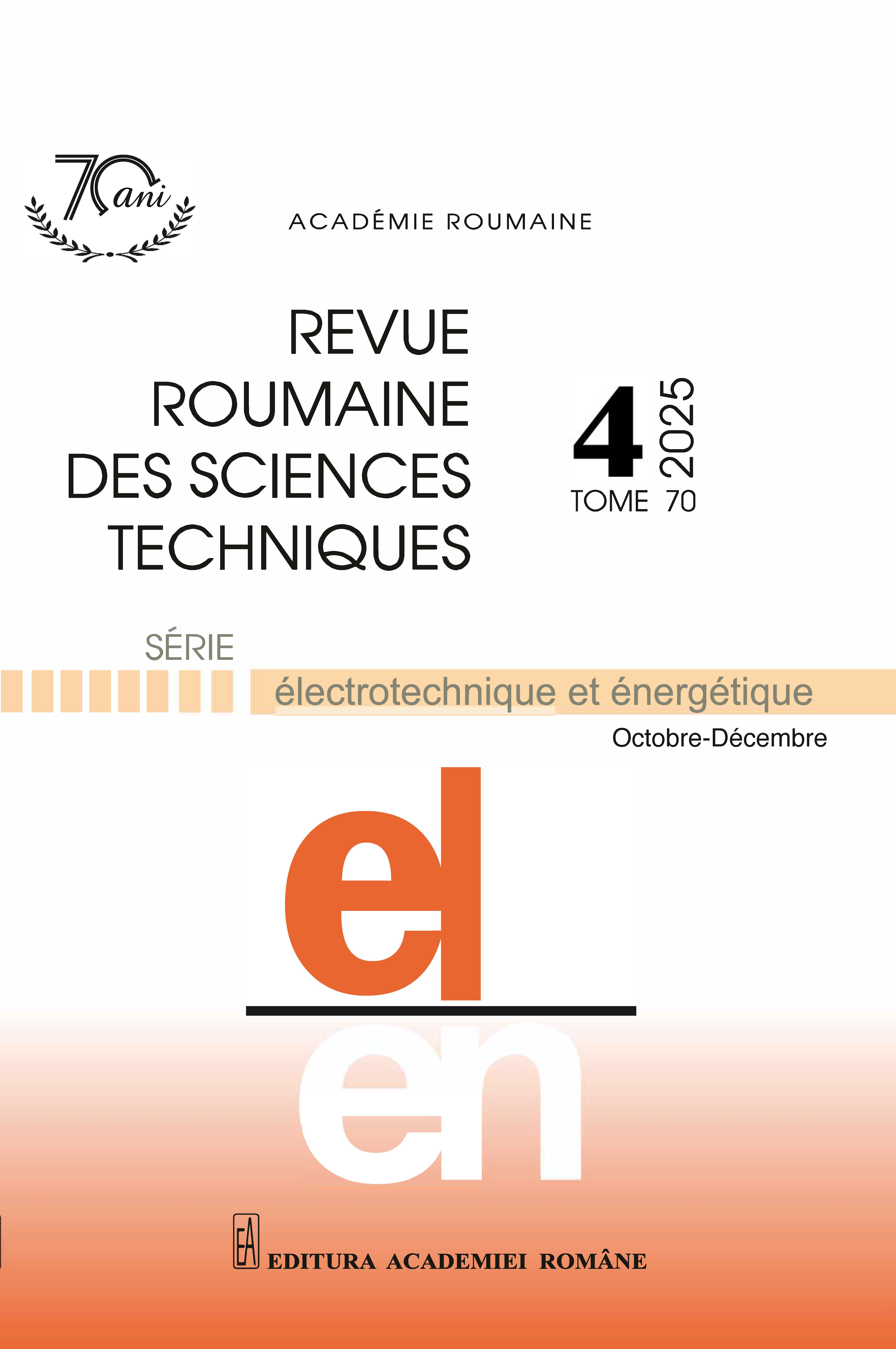ONDULEUR SYMÉTRIQUE À PLUSIEURS NIVEAUX ET À SOURCES MULTIPLES GÉNÉRALISÉ AVEC COMMUTATEURS RÉDUITS
DOI :
https://doi.org/10.59277/RRST-EE.2025.4.17Mots-clés :
Onduleurs multiniveaux, Multisource, Analyse de données, Décalage de niveau, Modulation de largeur d'impulsion, Convertisseur à inductance primaire asymétrique (SEPIC), Distorsion harmonique totaleRésumé
Cet article propose un onduleur symétrique multiniveau multisource généralisé avec un nombre réduit de commutateurs. La topologie proposée utilise moins de commutateurs, ce qui minimise les pertes de commutation et améliore l'efficacité du système. Les principales caractéristiques de cette topologie sont l'élimination des diodes et des condensateurs, un nombre réduit de commutateurs, la possibilité d'étendre le circuit pour atteindre autant de niveaux que nécessaire, une tension statique totale (TSV) réduite, un coût réduit et une distorsion harmonique totale (THD) plus faible. La technique de modulation de largeur d'impulsion à décalage de niveau et disposition de phase est utilisée, et des portes logiques sont employées pour générer des impulsions de déclenchement. La topologie proposée est simulée dans MATLAB/Simulink pour 11 niveaux, avec 5 sources CC et 9 commutateurs. L'analyse des performances pour les charges résistives et inductives a été effectuée. J'ai également fourni une comparaison détaillée avec d'autres travaux de recherche récents afin de démontrer l'efficacité du système proposé. La topologie proposée est également réalisée à l'aide du matériel pour une sortie à 11 niveaux.
Références
(1) D. Beriber, A. Talha, A. Kouzou, A. Guichi, and F. Bouchafaa, Multilevel inverter for grid-connected photovoltaic systems, Rev. Roum. Sci. Techn. – Électrotechn. Et Énerg., 67, 2, pp. 531–536 (2022).
(2) D. Ragul and V. Thiyagarajan, A novel fault-tolerant asymmetrical 21-level inverter topology with reduced components, Rev. Roum. Sci. Techn. – Électrotechn. Et Énerg., 68, 2, pp. 200–205 (2023).
(3) H. Khoun-Jahan, Switched capacitor-based cascaded half-bridge multilevel inverter with voltage boosting feature, CPSS Transactions on Power Electronics and Applications, 6, 1, pp. 63–73 (2021).
(4) T. Roy and P.K. Sadhu, A step-up multilevel inverter topology using novel switched capacitor converters with reduced components, IEEE Transactions on Industrial Electronics, 68, 1, pp. 236–247 (2021).
(5) S. Mustafa, A. Sarwar, M. Tariq, S. Ahmad, and H.A. Mahmoud, Development and control of a switched capacitor multilevel inverter, Energies, 16, 11 (2023).
(6) M.D. Siddique, S. Mekhilef, S. Padmanaban, M.A. Memon, and C. Kumar, Single-phase step-up switched-capacitor-based multilevel inverter topology with SHEPWM, IEEE Transactions on Industry Applications, 57, 3, pp. 3107–3119 (2021).
(7) T. Qanbari and B. Tousi, Single-source three-phase multilevel inverter assembled by three-phase two-level inverter and two single-phase cascaded H-bridge inverters, IEEE Transactions on Power Electronics, 36, 5, pp. 5204–5212 (2021).
(8) A. El Hajjaji, Performance evaluation of grid-connected T-type multilevel inverters, Renewable Energy & Power Quality Journal, 21, 1, pp. 583–588 (2023).
(9) F. Chakir, A. El Magri, R. Lajouad, M. Kissaoui, M. Chakir, and O. Bouattane, Design and analysis of a new multi-level inverter topology with a reduced number of switches and controlled by PDPWM technique, International Journal of Electrical and Computer Engineering Systems, 14, 5, pp. 593–600 (2023).
(10) E. Parimalasundar, N.M.G. Kumar, P. Geetha, and K. Suresh, Performance investigation of modular multilevel inverter topologies for photovoltaic applications with minimal switches, Electrical Engineering & Electromechanics, 6, pp. 28–34 (2022).
(11) Y. Wang, K. Wang, G. Li, F. Wu, K. Wang, and J. Liang, Generalized switched-capacitor step-up multilevel inverter employing single DC source, CSEE Journal of Power and Energy Systems, 8, 2, pp. 439–451 (2022).
(12) M.A. Hosseinzadeh, M. Sarebanzadeh, R. Kennel, E. Babaei, and M. Rivera, New generalized circuits for single-phase multisource multilevel power inverter topologies, IEEE Transactions on Power Electronics, 38, 6, pp. 6823–6830 (2023).
(13) U. Mustafa, M.S.B. Arif, R. Kennel, and M. Abdelrahem, Asymmetrical eleven-level inverter topology with reduced power semiconductor switches, total standing voltage and cost factor, IET Power Electron, 15, pp. 395–411 (2022).
(14) A. Priyadarshi, P.K. Kar, and S.B. Karanki, A single-source transformer-less boost multilevel inverter topology with self-voltage balancing, IEEE Transactions on Industry Applications, 56, 4, pp. 3954–3965 (2020).
(15) M.J. Sathik, N. Prabaharan, S. Ibrahim, K. Vijaykumar, and F. Blaabjerg, A new generalized switched diode multilevel inverter topology with reduced switch count and voltage on switches, International Journal of Circuit Theory Applications, 48, pp. 619–637 (2020).
(16) R. Barzegarkhoo, S.S. Lee, S.A. Khan, Y.P. Siwakoti, and D.D.C. Lu, A novel generalized common-ground switched-capacitor multilevel inverter suitable for transformerless grid-connected applications, IEEE Transactions on Power Electronics, 36, 9, pp. 10293–10306 (2021).
(17) M.D. Siddique, B. Prathap Reddy, A. Iqbal, and S. Mekhilef, Reduced switch count-based N-level boost inverter topology for higher voltage gain, IET Power Electronics, 13, pp. 3505–3509 (2020).
(18) A.K. R and L.P. Suresh, A brief review on multi-level inverter topologies, In 2016 International Conference on Circuit, Power and Computing Technologies (ICCPCT), Nagercoil, India, pp. 1–6 (2016).
(19) V. Thiyagarajan and P. Somasundaram, Design of a new symmetrical nine-level inverter with reduced number of switches, Rev. Roum. Sci. Techn. – Électrotechn. Et Énerg., 63, 2, pp. 196–201 (2018).
Téléchargements
Publiée
Numéro
Rubrique
Licence
(c) Copyright REVUE ROUMAINE DES SCIENCES TECHNIQUES — SÉRIE ÉLECTROTECHNIQUE ET ÉNERGÉTIQUE 2025

Ce travail est disponible sous licence Creative Commons Attribution - Pas d'Utilisation Commerciale - Pas de Modification 4.0 International.


